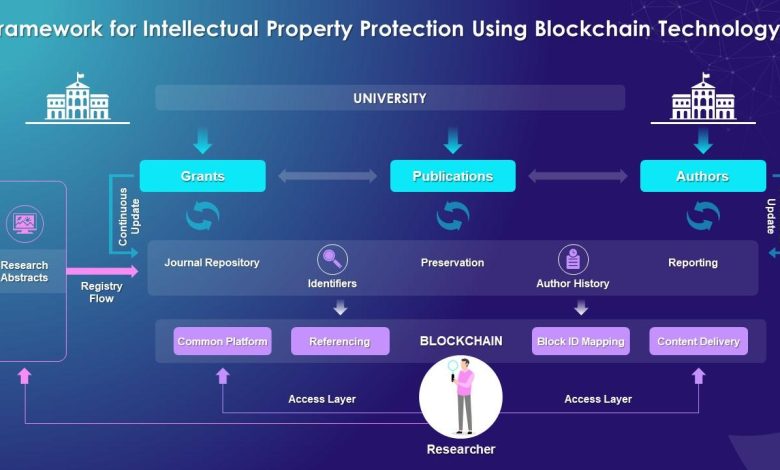Blockchain and Intellectual Property Protection

- Understanding the Basics of Blockchain Technology
- The Role of Blockchain in Intellectual Property Protection
- Challenges and Opportunities of Using Blockchain for IP Protection
- Case Studies: Successful Implementation of Blockchain in IP Protection
- Future Trends in Blockchain and Intellectual Property
- Key Considerations for Businesses Looking to Utilize Blockchain for IP Protection
Understanding the Basics of Blockchain Technology
Blockchain technology is a decentralized, distributed ledger system that securely records transactions across a network of computers. Each transaction is stored in a “block” that is linked to the previous block, forming a chain of blocks – hence the name “blockchain.” This technology ensures transparency, security, and immutability of data, making it an ideal solution for intellectual property protection.
One of the key features of blockchain technology is its ability to create a tamper-proof record of ownership and provenance. By storing information in a decentralized manner, blockchain eliminates the need for intermediaries, such as banks or government agencies, to verify the authenticity of intellectual property rights. This not only reduces costs but also minimizes the risk of fraud and infringement.
Smart contracts, which are self-executing contracts with the terms of the agreement directly written into code, play a crucial role in leveraging blockchain for intellectual property protection. These contracts automatically enforce the terms and conditions of an agreement, ensuring that all parties comply with the rules set forth in the contract. This can help streamline the process of licensing, royalty payments, and copyright enforcement.
Blockchain technology also enables the creation of digital tokens that represent ownership of intellectual property assets. These tokens can be traded on blockchain-based marketplaces, allowing creators to monetize their work directly without relying on traditional intermediaries. Additionally, blockchain can be used to timestamp creative works, providing irrefutable proof of authorship and creation date.
In conclusion, understanding the basics of blockchain technology is essential for leveraging its potential in intellectual property protection. By utilizing blockchain’s decentralized, transparent, and secure nature, creators can safeguard their intellectual property rights, streamline licensing processes, and create new revenue streams. Embracing blockchain technology in the realm of intellectual property can revolutionize the way we protect and manage creative assets in the digital age.
The Role of Blockchain in Intellectual Property Protection
Blockchain technology plays a crucial role in the protection of intellectual property rights. By utilizing blockchain, creators and innovators can securely store and timestamp their work, providing undeniable proof of ownership and creation date. This helps in preventing unauthorized use or infringement of intellectual property.
One of the key benefits of blockchain in intellectual property protection is its ability to create a transparent and immutable record of ownership. This decentralized ledger ensures that all transactions related to intellectual property are securely recorded and cannot be altered or tampered with.
Moreover, blockchain technology enables the creation of smart contracts, which can automatically enforce licensing agreements and royalty payments. This eliminates the need for intermediaries and reduces the risk of disputes or delays in the payment process.
Overall, blockchain technology offers a reliable and efficient solution for safeguarding intellectual property rights in the digital age. Its decentralized nature, transparency, and security make it an ideal tool for creators and innovators looking to protect their work from unauthorized use or infringement.
Challenges and Opportunities of Using Blockchain for IP Protection
When considering the challenges and opportunities of utilizing blockchain for intellectual property (IP) protection, it is essential to recognize the potential benefits and drawbacks of this innovative technology.
One of the primary challenges of using blockchain for IP protection is the complexity of implementing this technology. Blockchain requires a significant amount of technical expertise to set up and maintain, which can be a barrier for many organizations. Additionally, the decentralized nature of blockchain can make it difficult to regulate and enforce IP rights effectively.
On the other hand, blockchain offers numerous opportunities for enhancing IP protection. The transparency and immutability of blockchain can help establish a secure and tamper-proof record of ownership for intellectual property assets. This can be particularly beneficial for artists, inventors, and creators looking to protect their work from unauthorized use or infringement.
Furthermore, blockchain has the potential to streamline the process of licensing and royalty payments for IP rights holders. Smart contracts can be used to automate these transactions, ensuring that creators receive fair compensation for their work without the need for intermediaries.
In conclusion, while there are challenges to overcome, the opportunities presented by blockchain for IP protection are significant. By leveraging the unique features of blockchain technology, organizations can enhance the security and efficiency of protecting intellectual property rights in the digital age.
Case Studies: Successful Implementation of Blockchain in IP Protection
Several case studies have demonstrated the successful implementation of blockchain technology in intellectual property (IP) protection. These real-world examples showcase the effectiveness of blockchain in safeguarding IP rights and preventing unauthorized use or infringement.
- One notable case study involves a multinational corporation that utilized blockchain to create a secure and transparent system for tracking the ownership and usage rights of its patents, trademarks, and copyrights. By storing IP information on a decentralized ledger, the company was able to establish a tamper-proof record of its assets, reducing the risk of IP theft or disputes.
- Another example is a digital content creator who leveraged blockchain to protect their creative works from plagiarism and unauthorized distribution. By registering their creations on a blockchain platform, the artist was able to prove ownership and establish a timestamp for their intellectual property, making it easier to enforce their rights in case of infringement.
- Furthermore, a legal firm specializing in IP law successfully integrated blockchain into its practice to streamline the process of verifying and managing clients’ IP assets. By using smart contracts and digital signatures on a blockchain network, the firm was able to automate tasks such as licensing agreements, royalty payments, and IP transfers, reducing the administrative burden and ensuring compliance with IP regulations.
These case studies highlight the diverse applications of blockchain in IP protection, demonstrating its potential to revolutionize the way intellectual property is managed and enforced. By leveraging the security, transparency, and immutability of blockchain technology, businesses and individuals can enhance the protection of their valuable IP assets and mitigate the risks associated with unauthorized use or infringement.
Future Trends in Blockchain and Intellectual Property
Looking ahead, there are several future trends in the intersection of blockchain and intellectual property that are worth keeping an eye on. These trends have the potential to revolutionize the way intellectual property is protected and managed in the digital age.
- Smart Contracts: One of the most promising applications of blockchain technology in intellectual property protection is the use of smart contracts. These self-executing contracts can automatically enforce the terms of an agreement between parties, providing a secure and transparent way to manage intellectual property rights.
- NFTs: Non-fungible tokens (NFTs) have gained popularity in the art world, but they also have significant implications for intellectual property protection. By tokenizing digital assets on the blockchain, creators can prove ownership and authenticity, making it easier to protect their intellectual property rights.
- Data Integrity: Blockchain technology can be used to create an immutable record of intellectual property rights, ensuring that data related to patents, trademarks, and copyrights remains secure and tamper-proof. This can help prevent infringement and unauthorized use of intellectual property.
- Decentralized Copyright Management: Decentralized platforms powered by blockchain technology are emerging as a way to manage copyright and licensing rights in a more efficient and transparent manner. These platforms can streamline the process of licensing intellectual property and ensure that creators are fairly compensated for their work.
Overall, the future of blockchain and intellectual property protection looks promising, with innovative solutions on the horizon that have the potential to transform the way we think about and manage intellectual property rights in the digital age.
Key Considerations for Businesses Looking to Utilize Blockchain for IP Protection
When considering utilizing blockchain for intellectual property (IP) protection, businesses must take into account several key considerations to ensure a successful implementation. By understanding these factors, companies can effectively leverage blockchain technology to safeguard their valuable IP assets.
- Security: One of the primary benefits of blockchain technology is its high level of security. By utilizing cryptographic techniques, blockchain can provide a secure and tamper-proof way to store and manage IP information.
- Transparency: Blockchain offers transparency by providing a decentralized ledger that can be accessed by authorized parties. This transparency can help in establishing ownership rights and tracking the provenance of IP assets.
- Immutability: The immutability of blockchain ensures that once data is recorded, it cannot be altered or deleted. This feature is crucial for maintaining the integrity of IP records and preventing unauthorized modifications.
- Smart Contracts: Smart contracts can be used in conjunction with blockchain to automate IP-related processes, such as licensing agreements and royalty payments. These self-executing contracts can help streamline operations and reduce the risk of disputes.
- Interoperability: Businesses should consider the interoperability of blockchain with existing systems and protocols. Ensuring compatibility with other technologies can facilitate the seamless integration of blockchain for IP protection.
By carefully evaluating these key considerations, businesses can harness the power of blockchain to enhance their IP protection strategies and stay ahead in today’s digital economy.






